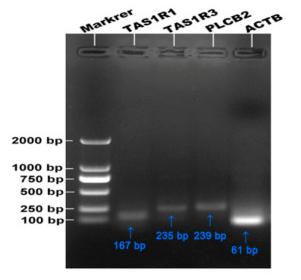TAS1R1 Antibody - #DF10278
| Product: | TAS1R1 Antibody |
| Catalog: | DF10278 |
| Description: | Rabbit polyclonal antibody to TAS1R1 |
| Application: | WB |
| Cited expt.: | WB |
| Reactivity: | Human, Mouse, Rat |
| Prediction: | Pig, Bovine, Horse, Sheep, Dog, Chicken |
| Mol.Wt.: | 93kDa; 93kD(Calculated). |
| Uniprot: | Q7RTX1 |
| RRID: | AB_2840856 |
Related Downloads
Protocols
Product Info
*The optimal dilutions should be determined by the end user. For optimal experimental results, antibody reuse is not recommended.
*Tips:
WB: For western blot detection of denatured protein samples. IHC: For immunohistochemical detection of paraffin sections (IHC-p) or frozen sections (IHC-f) of tissue samples. IF/ICC: For immunofluorescence detection of cell samples. ELISA(peptide): For ELISA detection of antigenic peptide.
Cite Format: Affinity Biosciences Cat# DF10278, RRID:AB_2840856.
Fold/Unfold
G protein coupled receptor 70; G protein-coupled receptor 70; G-protein coupled receptor 70; gm 148; gm148; GPR 70; GPR70; Krueppel related zinc finger protein 3 (HKR3 protein); seven transmembrane helix receptor; Sweet taste receptor T1r; T1R1; TAS1 R1; TAS1R1; Taste receptor type 1 member 1; taste receptor, type 1, member 1; TR 1; TR1; TS1R1_HUMAN;
Immunogens
A synthesized peptide derived from human TAS1R1, corresponding to a region within the internal amino acids.
- Q7RTX1 TS1R1_HUMAN:
- Protein BLAST With
- NCBI/
- ExPASy/
- Uniprot
MLLCTARLVGLQLLISCCWAFACHSTESSPDFTLPGDYLLAGLFPLHSGCLQVRHRPEVTLCDRSCSFNEHGYHLFQAMRLGVEEINNSTALLPNITLGYQLYDVCSDSANVYATLRVLSLPGQHHIELQGDLLHYSPTVLAVIGPDSTNRAATTAALLSPFLVPMISYAASSETLSVKRQYPSFLRTIPNDKYQVETMVLLLQKFGWTWISLVGSSDDYGQLGVQALENQATGQGICIAFKDIMPFSAQVGDERMQCLMRHLAQAGATVVVVFSSRQLARVFFESVVLTNLTGKVWVASEAWALSRHITGVPGIQRIGMVLGVAIQKRAVPGLKAFEEAYARADKKAPRPCHKGSWCSSNQLCRECQAFMAHTMPKLKAFSMSSAYNAYRAVYAVAHGLHQLLGCASGACSRGRVYPWQLLEQIHKVHFLLHKDTVAFNDNRDPLSSYNIIAWDWNGPKWTFTVLGSSTWSPVQLNINETKIQWHGKDNQVPKSVCSSDCLEGHQRVVTGFHHCCFECVPCGAGTFLNKSDLYRCQPCGKEEWAPEGSQTCFPRTVVFLALREHTSWVLLAANTLLLLLLLGTAGLFAWHLDTPVVRSAGGRLCFLMLGSLAAGSGSLYGFFGEPTRPACLLRQALFALGFTIFLSCLTVRSFQLIIIFKFSTKVPTFYHAWVQNHGAGLFVMISSAAQLLICLTWLVVWTPLPAREYQRFPHLVMLECTETNSLGFILAFLYNGLLSISAFACSYLGKDLPENYNEAKCVTFSLLFNFVSWIAFFTTASVYDGKYLPAANMMAGLSSLSSGFGGYFLPKCYVILCRPDLNSTEHFQASIQDYTRRCGST
Predictions
Score>80(red) has high confidence and is suggested to be used for WB detection. *The prediction model is mainly based on the alignment of immunogen sequences, the results are for reference only, not as the basis of quality assurance.
High(score>80) Medium(80>score>50) Low(score<50) No confidence
Research Backgrounds
Putative taste receptor. TAS1R1/TAS1R3 responds to the umami taste stimulus (the taste of monosodium glutamate). Sequence differences within and between species can significantly influence the selectivity and specificity of taste responses.
Cell membrane>Multi-pass membrane protein.
Belongs to the G-protein coupled receptor 3 family. TAS1R subfamily.
Research Fields
· Organismal Systems > Sensory system > Taste transduction.
References
Application: WB Species: Pigs Sample:
Restrictive clause
Affinity Biosciences tests all products strictly. Citations are provided as a resource for additional applications that have not been validated by Affinity Biosciences. Please choose the appropriate format for each application and consult Materials and Methods sections for additional details about the use of any product in these publications.
For Research Use Only.
Not for use in diagnostic or therapeutic procedures. Not for resale. Not for distribution without written consent. Affinity Biosciences will not be held responsible for patent infringement or other violations that may occur with the use of our products. Affinity Biosciences, Affinity Biosciences Logo and all other trademarks are the property of Affinity Biosciences LTD.

